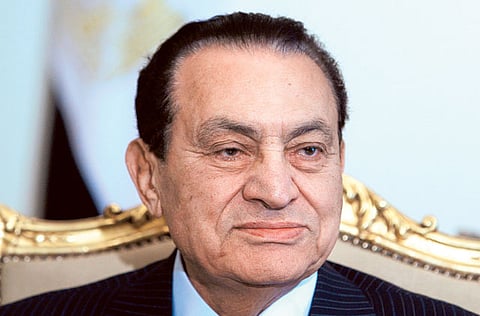Former Egyptian president Hosni Mubarak dies aged 91
Mubarak ruled Egypt for a period of 30 years before he was forced to step down in 2011

Dubai: Egypt’s former president Hosni Mubarak, who was forced to quit in a 2011 uprising, died Tuesday at 91, state television reported. He died in a military hospital in Cairo where he had stayed in recent weeks.
Last month, Mubarak underwent surgery in the hospital to remove an undisclosed tumour in the stomach.
Thabet, a former high-ranking military official, confirmed the family was still at the hospital and said the Egyptian presidential office would organise the funeral.
Last October, he appeared in a rare YouTube video reminiscing about Egypt’s war against Israel in 1973 when he was the chief of the air force.
Humble beginnings
Mubarak was a 24-year-old air force pilot when the military overthrew King Farouk in 1952.
The son of a government clerk, he was born Mohammad Hosni El Sayed Mubarak in the Nile Delta village of Kafr Musailha on May 4, 1928, when Egypt was still heavily supervised by Britain, which controlled the Suez Canal.
Details of his early life are sketchy. He qualified as a pilot in 1950 and spent more than two years in the Soviet Union a decade later, training to fly bombers.
Egypt and I shall not be parted until I am buried in her soilHosni Mubarak
When much of the air force was wiped out by Israeli warplanes in the Six-Day War of 1967, he was made head of the air force academy, charged with rebuilding air power to hit back.
As head of the air force from 1972, he did just that, attacking Israel in 1973.
Sadat, who succeeded Gamal Abdel Nasser in 1970, saw in Mubarak a loyal subordinate and made him vice president in 1975.
That office would lie vacant under Mubarak, who guarded his power jealously.
As president, Mubarak sent the army in to quell mutineers in the 1980s, and also repaired relations with Arab states after Sadat's peace with Israel. In 1989, Egypt was readmitted to the Arab League, which moved its headquarters back to Cairo.
In 1995, Mubarak survived one of several assassination attempts when Islamist gunmen fired on his car during a visit to Ethiopia.
A command economy fashioned under the Arab socialist Nasser lagged behind countries Egypt was once compared to, such as Turkey or South Korea. Egypt's population almost doubled under Mubarak, but many remained mired in deep poverty.
A spurt of growth in his final decade, fuelled by market reforms overseen by his son Gamal, made some rich, but corruption ensured the wealth stuck to the elite around the head of state, the military and those who found favour in the National Democratic Party (NDP).
Also Read: Hosni Mubarak: Egypt’s longest-serving ruler
Politically, there was talk of reform, not least when former U.S. President George W. Bush was pushing the idea. After winning a series of single-candidate referendums that provided the legal basis of his rule, Mubarak agreed to contest a presidential election in 2005. But the defeat of Ayman Nour, a liberal lawyer who dared challenge him, was no surprise.
Revolution
By 2010, the NDP felt confident enough of its impunity to claim 90% of the seats in a parliamentary election that saw the Muslim Brotherhood eliminated from the legislature.
The resulting public outrage might have subsided, as it had before, had it not been for the sudden success of an uprising in Tunisia just a few weeks later which also prompted protests against Egypt's ruler.
At first, Mubarak gave little ground to the hundreds of thousands of demonstrators in Cairo's Tahrir Square, comforted by hesitation in Western capitals to cut loose an ally.
Only when his generals began to desert him, fearful their own privileges might be swept away, and the Americans sided with the popular will, did he relent, at first insisting he would retire only later but finally flown off to his Red Sea retreat.
"Egypt and I shall not be parted until I am buried in her soil," he said. He was arrested two months later.
A trial began in August 2011, the sight of Mubarak in a courtroom cage captivating viewers.
On June 2, 2012, just before Brotherhood candidate Mohamed Mursi won the presidency, Mubarak was jailed for life for conspiring to murder protesters, sent to Cairo's Tora Prison though occasionally moved to the smart Maadi military hospital nearby due to claims of failing health.
Prison time would be short, however, as another military man, Abdel Fattah Al Sisi, overthrew Mursi the following year.
As Sisi launched a crackdown on the Brotherhood that critics said was more severe than anything under Mubarak, the case against the former president was dropped in 2014.
Three years later, following an appeal by the prosecution, Egypt's top appeals court acquitted him, allowing him to return to his home the upscale Cairo neighbourhood of Heliopolis, not far from the presidential palace he had occupied for nearly three decades.
Sign up for the Daily Briefing
Get the latest news and updates straight to your inbox







